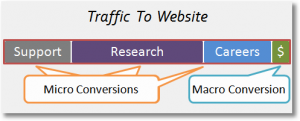The web analytics mire: What matters, what doesn’t, and how you can stop spinning
I despise web analytics. Does that surprise you? Maybe, if we’ve never met and you don’t know that I’m an idealist nerd writing a fantasy novel on the weekends. In high school, I managed to B- my way through advanced algebra and trigonometry, but that grade came through late nights studying with my father at the kitchen table. My senior year I skipped the expected course, calculus, to slide through on the minimum math requirements for graduation. I’m not ashamed.
I’ll qualify my statement: I despise web analytics that mean nothing. There’s little more painful or fruitless than looking at page views, bounce rates, click-through rates and visitor numbers, trying to turn that data into something useful for strategic momentum. At Occam’s Razor, Avinash explains, “Ask every web metric you report “so what” three times… If at the third “so what” you don’t get a recommendation for an action you should take, you have the wrong metric. Kill it.”
After a few years at EVG, I landed a project that required me, as project manager, to report on website analytics. I wept. I jumped at the chance to push myself past my comfort zone, moving from content marketing to strategy. After all, what is strategy if you can’t measure results and use those to get better/smarter?
I learned everything I could from the math- and analytics-minded folks here, and from every industry blog I could print, highlight, and learn by heart. This is how it’s done, friends. Analytics wizards are not smarter than you. They’ve simply put in the time. They’ve paid their dues. They’ve [insert another cliché about hard work and invested time].
You’re waiting for the secret. It’s a three parter:
- Ask yourself: What is the purpose of my website?
Answer in 10 words or less. If your site is business-to-consumer, you may or may not be running an e-commerce site. Can people buy things from your site? There’s your purpose: Make the sale. Can people use your site to educate themselves on your products or services? Your purpose is still sales, but that’s a little trickier, isn’t it? Your potential buyer can’t love.click.buy. – so you’re working even harder to get them in your store.
B2B sites are really no different. It just seems harder. Most industrial-sector websites are not e-commerce. What’s your purpose then? When you know that, according to SiriusDecisions, 70% of the buying process in a complex sale is already complete before prospects are willing to engage with a live sales person, you’d better find it fast. - Ask yourself: If that is the purpose, how do I measure the success or failure in reaching that purpose?
Conversion isn’t just a sale. You choose your conversion(s). If your sole measure of effectiveness or failure is based on one conversion goal, you’re probably very disappointed indeed. Conversion rates for most sites are below 2%. What about the other visitors to your site that don’t “convert?” Are those useless? If you’ve consistently ignored numbers that aren’t directly related to traffic and conversion, you’re losing.
For simplicity’s sake, say your website sees 1,000 visits a day. Say your conversion rate is around 1%, which is typical. Out of every 1,000 visitors, 10 convert. That’s great. What about the other 990 visitors?

Can you feel the magic? This is an Avinash graphic, and it demonstrates my point. Your primary conversion (buying, filling out a RFQ, whatever) is the macro-conversion. It’s the tip-top, mmm-mmm pinnacle of web analytics happiness.The other 990 fall down on the spectrum, but their visits are worthwhile even if they’re not buying. These are real, live humans looking at your website! Get UP about that.
Why are they there? You measure those “other than conversion” reasons as micro-conversions. Are they reading your blog? Are they contacting your support team? Downloading white papers? Those are useful actions. These are pre-buy steps that shorten your sales cycle. Measure them.
- Ask yourself: How will what I learn change my strategy?
In digital marketing, if you’re not flexible you fail. If you’re not willing to change, you fail. If you can’t move quickly – you got it – you fail. Once you have useful metrics in place and you start understanding the strengths and weaknesses of your site, you’ll quickly know what needs to change. Be willing to embrace that. Analytics without understanding and action is just a number dump.

I’ll be speaking more on analytics and ROI at Manufacturing Marketing Innovation 2013. If you haven’t signed up, go do that – we can talk strategy over the hors d’oeuvre table.
Sara Fraser – VP Content Strategy




